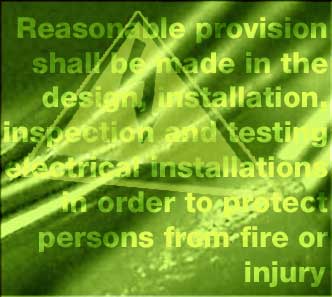
Simply put:
With a few exceptions any electrical work undertaken in a dwelling which includes the addition of a new electrical circuit, or involves work in the:
Kitchen
Bathroom
Garden area
must from 1st January 2005 be reported to the Local Authority Building Control for inspection. This includes work undertaken professionally, by a householder or householders family member or friend.
The ONLY exception is when the installer has been approved by a Competent Persons organization details of these can be found here.

* A new requirement, has been added to Schedule 1 of the Building Regulations. This requirement, ‘Requirement P', has been limited to fixed electrical installations in dwellings, with minor works not needing to be notified.
* A new Approved Document P has been published, giving guidance on ways of complying that are based on the fundamental principles set out in Chapter 13 of BS 7671: 2001.
The Approved Document includes:
* Guidance relating to the design, installation, inspection and testing of electrical installations.
* Guidance on types of electrical work that would not normally need to be notified to building control bodies
* Appendices that contain illustrations of the sorts of electrical services commonly required in homes, examples of model electrical installation certificates, and illustrations of what equipment may be encountered when work is carried out on older electrical installations.
The Requirement
The Building Regulations apply when building work is undertaken. Part P will redefine building work to include electrical work on certain types of fixed electrical installation in dwellings. The new requirement in the Building Regulations, ‘Requirement P', is simply that:
P1 Design, Installation, Inspection and Testing
Reasonable provision shall be made in the design, installation, inspection and testing of electrical installations in order to protect persons from fire or injury.
P2 Provision Information
Sufficient information shall be provided so that persons wishing to operate, maintain or alter an electrical installation can do so with reasonable safety.
The limits on the application of the requirement is that Requirement P applies only to fixed electrical installations that are intended to operate at low voltage or extra-low voltage which are not controlled by the Electricity Supply Regulations 1988 as amended, or the Electricity at Work Regulations 1989 as amended.
Enforcement
Failure to comply with the requirement will be a criminal offense. Local authorities will also have the power to require the removal or alteration of work that does not comply with the Building Regulations.
Intended work that is subject to the provisions of Part P will have to be notified to the local authority. Traditionally, work notifiable under the Building Regulations is subject to inspection by the local authority's building control department (or other approved building inspector). However, to avoid the need for local authorities to appoint specialist agents for this purpose, it appears likely that building control bodies would be authorized to accept certificates of compliance (ie Electrical Installation Certificates) issued by ‘Competent Firms'.
Under such Competent Firms provisions, appropriately approved electrical contractors are able to self-certify that their work meets the requirements of the Building Regulations. In this case there will be a need to supply the relevant building control body (as well as the person ordering the work) with an Electrical Installation Certificate signed by a competent person. The alternative would be to pay a fee to have the work inspected by a local authority building control department, or other approved private sector building inspector.